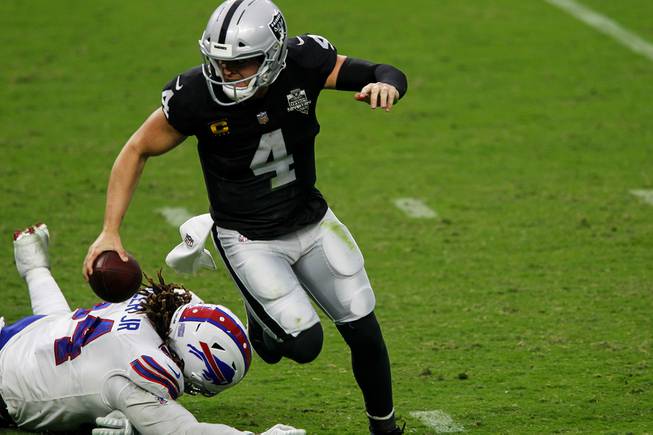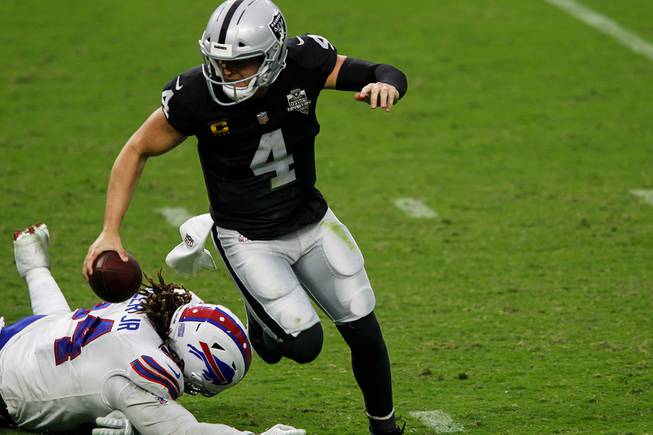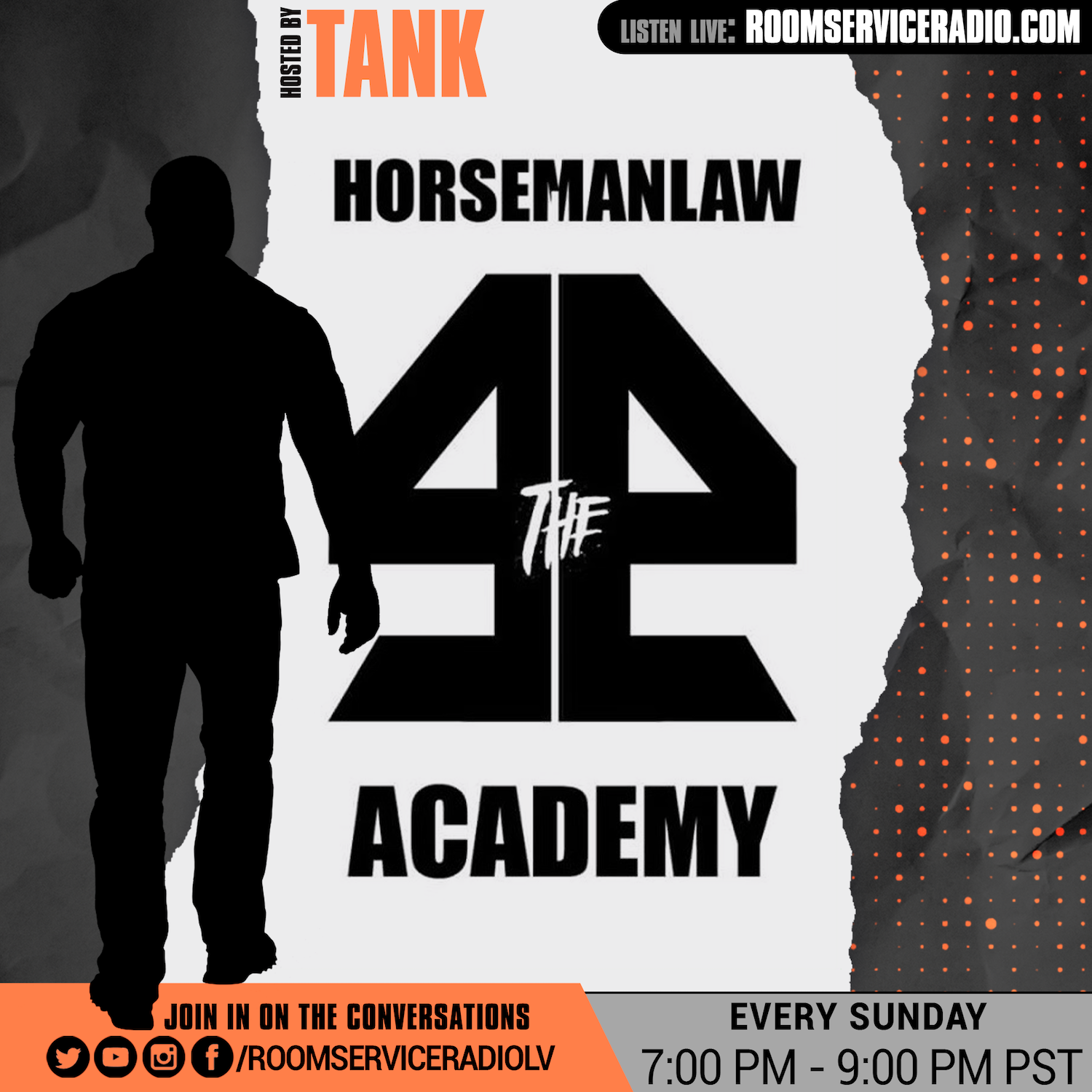
Raiders quarterback Derek Carr avoids being tackled by Buffalo defensive tackle Vernon Butler at Allegiant Stadium Sunday, Oct. 4, 2020.
Tuesday, Oct. 6, 2020 | 2 a.m.
The NFL season is still young, but in this unprecedented 2020 campaign — when no game can even be guaranteed to be played on a week-to-week basis — the only thing that matters is the present. And right now, the Raiders are a 2-2 team.
We’ve seen some good and some bad from Las Vegas, and a mini two-game losing streak has the arrow pointing slightly downward at the moment. At this point, however, the Raiders could end up going either way.
There have been a handful of plays that have defined the season so far. They may not be the biggest, most explosive or most important plays, but each is indicative of a larger theme or trend that has developed through the first four weeks of the season.
Lack of pass rush
One of the front office’s top offseason goals was to improve the pass rush, and it hasn’t worked. Actually, through the first quarter of the season it appears to have gotten worse. Defensive linemen Clelin Ferrell, Maliek Collins, Johnathan Hankins and Arden Key have combined for 0.0 sacks. Big free-agent acquisition Carl Nassib has contributed 0.5 sacks.
The only non-disappointment has been Maxx Crosby, who has bagged three sacks, but that hasn’t been nearly good enough to elevate the defense as a whole. The Raiders currently rank 31st out of 32 teams in sack rate (2.9 percent).
Collins was touted throughout training camp as a key to the defense, but either the coaching staff vastly overestimated his impact or he’s in a massive slump.
This play from the Week 3 loss to the Patriots pretty much sums up the defensive line’s struggles, as Collins got single-blocked (and pancaked) by sixth-round rookie left guard Michael Onwenu:
More than anything else that cropped up through the first four games, the Raiders need to figure out their pass-rush issues.
Carr accuracy reaching new heights
The best thing the Las Vegas offense has going for it is the accuracy of Derek Carr. He doesn’t go deep very often or take a lot of risks, but that’s not his game — his game is being precise and moving the chains with a succession of on-target throws.
And Carr has been at the top of his game this year. He has completed better than 72 percent in each of the four contests, and for the season he’s sitting at 73.6 percent for 1,095 yards with eight touchdowns and no interceptions. He’s even averaging a career high in air yard per attempt (8.7 yards), according to Pro-Football Reference.
His best throw of the year might have been this 15-yard touchdown pass to Zay Jones, which was just perfectly place:
Fans want Carr to take more risks and go for the big play more often, but he isn’t just tasked with scoring points — he also has to protect his defense, which means minimizing turnovers and maximizing possession time. He has done a good job of that so far.
Youth in the secondary
The Raiders are dedicated to a youth movement in the defensive backfield, as they start a rookie cornerback (Damon Arnette), a second-year cornerback (Trayvon Mullen) and a second-year safety (Johnathan Abram, who played all of one game as a rookie). That approach has, as expected, led to a lot of variance in the play of the secondary as a whole.
Las Vegas’ youth got exposed early in the Week 4 loss to Buffalo. With Arnette out due to injury, fourth-round rookie Amik Robertson suited up for the first time and the Bills made sure to attack him immediately.
On the first drive of the game, Robertson bit hard on an underneath route, but Gabriel Davis broke it upfield and raced wide open in to the end zone for a 26-yard touchdown:
Robertson ended up playing just nine defensive snaps on the day, and there are surely better days ahead for him. And that goes for the rest of the young secondary, but right now this is an inexperienced group that is prone to mistakes.
Back-end issues
Coverage has been spotty, as addressed above, but tackling has been a major problem, too.
Johnathan Abram has drawn most of the attention on that front, and that’s justified, as his hard-charging style and desire to lay the big hit has left him vulnerable to cutbacks and resulted in a lot of missed tackles.
This play, a key third down late in the first half, was a particularly egregious example. A stop here and the Raiders survive and get into the locker room feeling good about themselves; instead, Abram fired at the running back on a screen pass and missed by a mile, allowing a game-turning touchdown:
That play really hurt, but the Abram Experience hasn’t been all bad. He lays the lumber in the running game, and you can’t deny that he plays with force and attitude, bringing good energy to a defense that is too often passive and reactionary.
On this play from the same game, he got into the backfield and chased down Cam Newton, perhaps the biggest, most athletic and most powerful running QB in the game. Abram got him to the ground in a one-on-one situation in space, which is not easy to do, and even smacked the ball out of Cam’s hand after the play just to make a point:
Abram misses a lot and connects a lot; the Raiders hope that ratio skews more toward the positive side over the rest of the season.
Flashes only
The Raiders spent a lot of draft capital to reshape their skill positions, but we’ve only seen flashes of it so far. Third-round “running back” Lynn Bowden was shipped out in a trade before playing a single game in silver and black, and first-round pick Henry Ruggs managed to play about five minutes before getting banged up. Ditto third-round receiver Bryan Edwards.
The good news has been the flashes, like Ruggs’ introduction to the NFL in Week 1.
Las Vegas got him matched up on a safety in deep zone coverage, and Ruggs was able to simply run away from him across the field, resulting in the easiest 45-yard completion of Derek Carr’s career:
That was one of just four catches for Ruggs so far; Edwards has pulled in five receptions. It’s not the kind of production the Raiders were hoping for, but the good stuff has been intriguing.
Time to throw
One of the reasons Carr has been so accurate is because he has all day to stand in the pocket. His offensive line has been beset by injuries, but they’re still playing like one of the best pass-blocking units in the league.
Carr is currently being sacked on 4.6 percent of dropbacks, which is his lowest rate since 2017. And when he has time to let deeper routes develop, the offense can pick up more chunk plays, like they did in Week 2 against New Orleans.
The Saints rushed four defensive linemen on this play, and the Raiders’ blockers ate them up. Carr had a huge pocket and wide throwing lanes, and he waited almost five full seconds — an eternity in football time — before hitting Edwards on a deep crossing route for 22 yards:
That’s not really a fluke for the Raiders’ offensive line. It’s indicative of the time Carr has had in the pocket in each of the four games, and if that’s the kind of protection he gets the rest of the way he’ll put up career-best numbers across the board.
Run game lagging
The Raiders have been pretty dominant when it comes to pass blocking, but the team’s running game is lagging behind. Maybe it’s due to the injuries and shuffling up front, but Las Vegas ranks just 15th in rush yards per game (115.2) and 19th in yards per attempt (4.2). That’s not good enough for a team that wants to rely on its power game to control the clock.
The positive spin is that the Raiders are capable of opening holes. The offensive line is talented and cohesive, and when they’re on the same page good things happen.
At Carolina, they mauled the Panthers to the tune of 133 rushing yards and three touchdowns on the ground, including this impressive TD:
The blocking was powerful and coordinated. Tight ends Darren Waller and Jason Witten picked up their outside assignments, while center Rodney Hudson and left guard Richie Incognito double-teamed the nose tackle out of the play entirely (even taking the middle linebacker with them). Right guard Gabe Jackson destroyed his one-on-one block, pancaking his man to clear the way for Josh Jacobs to walk into the end zone untouched for a 7-yard score.
That’s the ceiling for the offensive line. When the unit is whole again and firing on all cylinders, the running game should pick up and serve as an efficient complement to the rest of the offense.
Mike Grimala can be reached at 702-948-7844 or [email protected]. Follow Mike on Twitter at twitter.com/mikegrimala.













